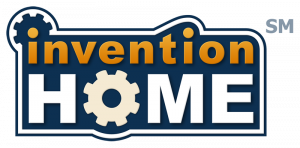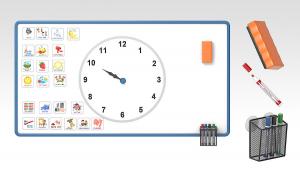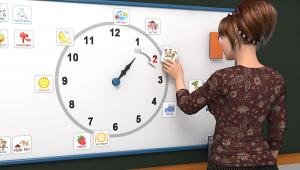InventionHome® Inventor Creates Whiteboard Featuring a Clock to Help Children Remember Daily Schedules
MONROEVILLE, PA, USA, April 26, 2024 /EINPresswire.com/ --
Michaela O. of Provo, UT is the creator of the Tot Clock, a whiteboard device equipped with a clock and multiple magnetic laminated pictures to help children identify and maintain a daily schedule. The pictures function as a schedule when placed at different times on the clock to let children know what they will or should be doing at specific times of day. The device will come with approximately 200 laminated pictures with magnets on their back that can be placed at any position on the clock. When the hour hand of the clock points to one of these laminated pictures, it means that the children should begin whatever the picture indicates. The clock is battery operated and moves on its own throughout the day.
The whiteboard can also come with a marker and eraser, hanging materials, and number stickers. Leftover space can be used for writing a schedule and other reminders. Children can examine the board at any time of day to understand what they should be doing at that time. The whiteboard and its clock help ease anxiety in young children regarding telling time and their daily schedules, helping reduce the number of times parents, teacher, babysitters, etc. must remind children what they should be doing throughout the day. The device is great for parents that need to keep their children occupied, and it can be especially useful for young children with autism, taking away the stress of figuring out what to do every moment of the day.
It is often difficult for parents, teachers, and other adult figures in a child’s life to maintain their attention on a daily schedule. Children get distracted often and are unable to remember what they should be doing at a specified time. Furthermore, some young children may have anxiety about learning how to tell time. They may know about getting in trouble if a task is not completed at a certain time; however, standard analog clocks and watches are difficult for children to learn at a first glance.
Keeping children entertained and engaged is an important part of their education. Looking at standard watches and analog clocks is boring for a child, and more interactive methods are required. Many educational toys for young children, such as wooden clocks with movable hands or interactive learning pads, include features that help children grasp the concept of time and how to read clocks. The market for these types of toys and tools is influenced by traditional teaching methods, adult figure involvement, and educational policies, each aimed at enhancing a child’s time-telling abilities in a dynamic way.
The Tot Clock utilizes several innovative features capable of fitting in this niche industry. The additional whiteboard space surrounding the clock area is incredibly versatile and multiplies its functionality, offering an educational tool that would significantly enhance any manufacturer’s product line.
Michaela filed her Utility Patent with the United States Patent and Trademark Office (USPTO) and is working closely with InventionHome, a leading invention licensing firm, to sell or license the patent rights to her Tot Clock product. Ideal licensing candidates would be U.S. based product manufacturers or distributors looking to further develop and distribute this product innovation.
Companies interested in the Tot Clock can contact InventionHome at member@inventionhome.com. Inventors currently looking for assistance in patenting, marketing, or licensing their invention can request information from InventionHome at info@inventionhome.com or by calling 1-866-844-6512.
About InventionHome®
InventionHome is a leading invention and product licensing firm focused on helping inventors and entrepreneurs through the invention and patent process with the goal of licensing or wholesaling client inventions. For more information, email info@inventionhome.com or visit https://www.inventionhome.com.

Michaela O. of Provo, UT is the creator of the Tot Clock, a whiteboard device equipped with a clock and multiple magnetic laminated pictures to help children identify and maintain a daily schedule. The pictures function as a schedule when placed at different times on the clock to let children know what they will or should be doing at specific times of day. The device will come with approximately 200 laminated pictures with magnets on their back that can be placed at any position on the clock. When the hour hand of the clock points to one of these laminated pictures, it means that the children should begin whatever the picture indicates. The clock is battery operated and moves on its own throughout the day.
The whiteboard can also come with a marker and eraser, hanging materials, and number stickers. Leftover space can be used for writing a schedule and other reminders. Children can examine the board at any time of day to understand what they should be doing at that time. The whiteboard and its clock help ease anxiety in young children regarding telling time and their daily schedules, helping reduce the number of times parents, teacher, babysitters, etc. must remind children what they should be doing throughout the day. The device is great for parents that need to keep their children occupied, and it can be especially useful for young children with autism, taking away the stress of figuring out what to do every moment of the day.
It is often difficult for parents, teachers, and other adult figures in a child’s life to maintain their attention on a daily schedule. Children get distracted often and are unable to remember what they should be doing at a specified time. Furthermore, some young children may have anxiety about learning how to tell time. They may know about getting in trouble if a task is not completed at a certain time; however, standard analog clocks and watches are difficult for children to learn at a first glance.
Keeping children entertained and engaged is an important part of their education. Looking at standard watches and analog clocks is boring for a child, and more interactive methods are required. Many educational toys for young children, such as wooden clocks with movable hands or interactive learning pads, include features that help children grasp the concept of time and how to read clocks. The market for these types of toys and tools is influenced by traditional teaching methods, adult figure involvement, and educational policies, each aimed at enhancing a child’s time-telling abilities in a dynamic way.
The Tot Clock utilizes several innovative features capable of fitting in this niche industry. The additional whiteboard space surrounding the clock area is incredibly versatile and multiplies its functionality, offering an educational tool that would significantly enhance any manufacturer’s product line.
Michaela filed her Utility Patent with the United States Patent and Trademark Office (USPTO) and is working closely with InventionHome, a leading invention licensing firm, to sell or license the patent rights to her Tot Clock product. Ideal licensing candidates would be U.S. based product manufacturers or distributors looking to further develop and distribute this product innovation.
Companies interested in the Tot Clock can contact InventionHome at member@inventionhome.com. Inventors currently looking for assistance in patenting, marketing, or licensing their invention can request information from InventionHome at info@inventionhome.com or by calling 1-866-844-6512.
About InventionHome®
InventionHome is a leading invention and product licensing firm focused on helping inventors and entrepreneurs through the invention and patent process with the goal of licensing or wholesaling client inventions. For more information, email info@inventionhome.com or visit https://www.inventionhome.com.
InventionHome
InventionHome
+1 866-844-6512
info@inventionhome.com
Legal Disclaimer:
EIN Presswire provides this news content "as is" without warranty of any kind. We do not accept any responsibility or liability for the accuracy, content, images, videos, licenses, completeness, legality, or reliability of the information contained in this article. If you have any complaints or copyright issues related to this article, kindly contact the author above.



